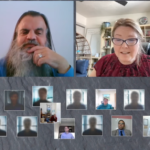
This is a follow-up to my recent research about Teaching and Learning in the Digital Age. I’ve spent considerable time thinking about how to alter the classes I teach to re-center them on a core of flexible learning. In all of my classes this semester, students will be completing a variety of learning projects that involve alternative ways to learn (e.g. blogging, making mindmaps, teaching a lesson, making a video presentation, or designing a non-digital game).
The difficult part about including these alternative learning methods is teaching the students all the necessary technology skills first. Most of my students are the traditional freshman-level age-range (18-25). For the most part, they “get” technology (cell phones, facebook, video games, and gadgets), but they haven’t been taught how to do anything productive with technology – at least, not with regards to learning or career skills.
If America wants to continue to be a world-leader, we can do it with a technology advantage – but only if we actually know how to leverage that technology to continue to be more productive.
So, I began to write out a list of the tech skills that I think students should learn before they leave college. Ideally, these are skills that would be integrated throughout K-12 and college curricula.
Basic Web Stuff
1. Basics of HTML (bold, underline, italics, special characters)
2. How to use EMBED code or make a live link
3. How to make and share a screenshot
4. How to make and share a short video explaining something or asking for help
5. Learn basic abbreviations and emoticons (e.g. ROFL, IMHO)
6. How to build a landing page for your web-based stuff (e.g. iGoogle, NetVibes)
7. How to add gadgets or plug-ins for various sites
8. How to make a simple website (e.g. Google Sites)
9. Build a clickable resume / digital portfolio
10. How (and when) to use collaborative documents or spreadsheets
11. How (and why) to create tags and labels
12. How (and why) to use URL-shortening sites (e.g. TinyURL)
Organization
13. How to set up a web-based calendar and use it to manage your time
14. How to set up and manage an RSS reader
15. How to find a common meeting time (e.g. Doodle)
16. How to set up a communication aggregator (e.g. Digsby, Trillian, TweetDeck)
Communication
17. How to manage email
18. How to write a good “first-contact” email
19. How to write a good subject line
20. How to write a good email response
21. Texting etiquette (when it’s appropriate, when it’s not)
22. How to summarize your thoughts in 140 characters or less
23. How to use Twitter (reply, retweet, direct message)
24. How to determine whether you should share it in a public forum (will it affect your future job prospects, your current employment, etc.)
25. How to manage an online meeting
26. How to give an effective webinar
27. What are the differences between various social networks and how they are used? (e.g. Facebook, Ning, LinkedIn)
Finding and Managing Information
28. How to use web-based bookmarks
29. How (and when) to use library search databases
30. How (and when) to use an image-based search engine
31. How (and when) to use alternate search engines (e.g. Clusty)
32. Who writes Wikipedia articles and when can they be trusted?
33. How to build a custom search engine
34. When can you trust the information you find?
35. How to use article citations to find better references
36. How to manage a bibliography online (e.g. Zotero)
37. How to set up web alerts to track new information (e.g. Google Alerts)
Privacy, Security, and the Law
38. Creative Commons – what is it and how to choose appropriate license?
39. How to read the legalese that tells you who owns it after it is shared online
40. What should you share and how does that change for different audiences?
41. How to manage usernames & passwords
42. How to find and tweak the privacy settings in common social networking sites (e.g. Facebook, MySpace, and Twitter)
43. How do data-mining sites get your information? (e.g. participating in FB quizzes)
44. What are the security concerns with GPS-based tracking systems?
Presentation
45. How to determine the audience and appropriate length for your presentation
46. Good presentation design principles
47. Principles of storytelling
48. How to share a set of slides on the Internet
49. How to build a non-linear presentation
50. How to build a flashy presentation (and when to use it)
51. How to find high-quality images that can be used in presentations (with appropriate copyrights)
52. How to find audio that can be shared in a presentation (with appropriate copyrights)
53. How to create a captioning script for a video
54. Ways to caption an internet-based video
55. How (and when) to use a virtual magnifier with your presentation
Ways to Learn
56. How to build an interactive mindmap to organize ideas
57. How to use a blog to track your learning process
58. How to find good sites, blogs, and other online publications for the topic you are learning about
59. How to cultivate a personal learning network (PLN)
60. How to participate in a live learning chat (e.g. TweetChats)
Okay, that’s sixty items and I’ve just scratched the surface (I haven’t even touched on virtual worlds, for instance).
The big problem? How many educators do you know that have these skills?



